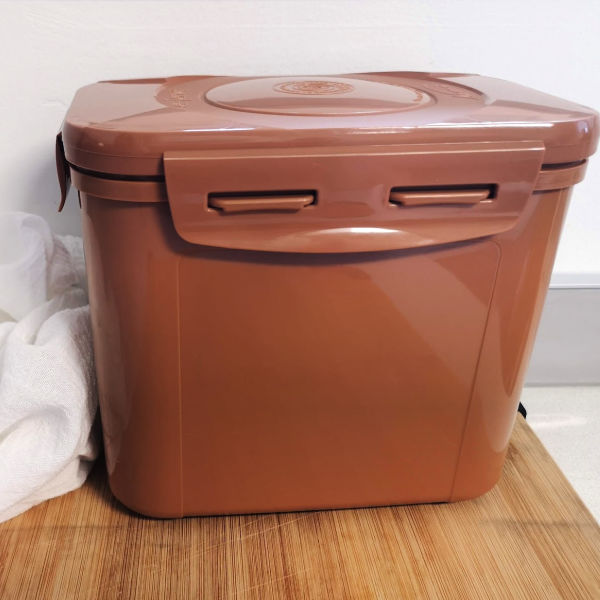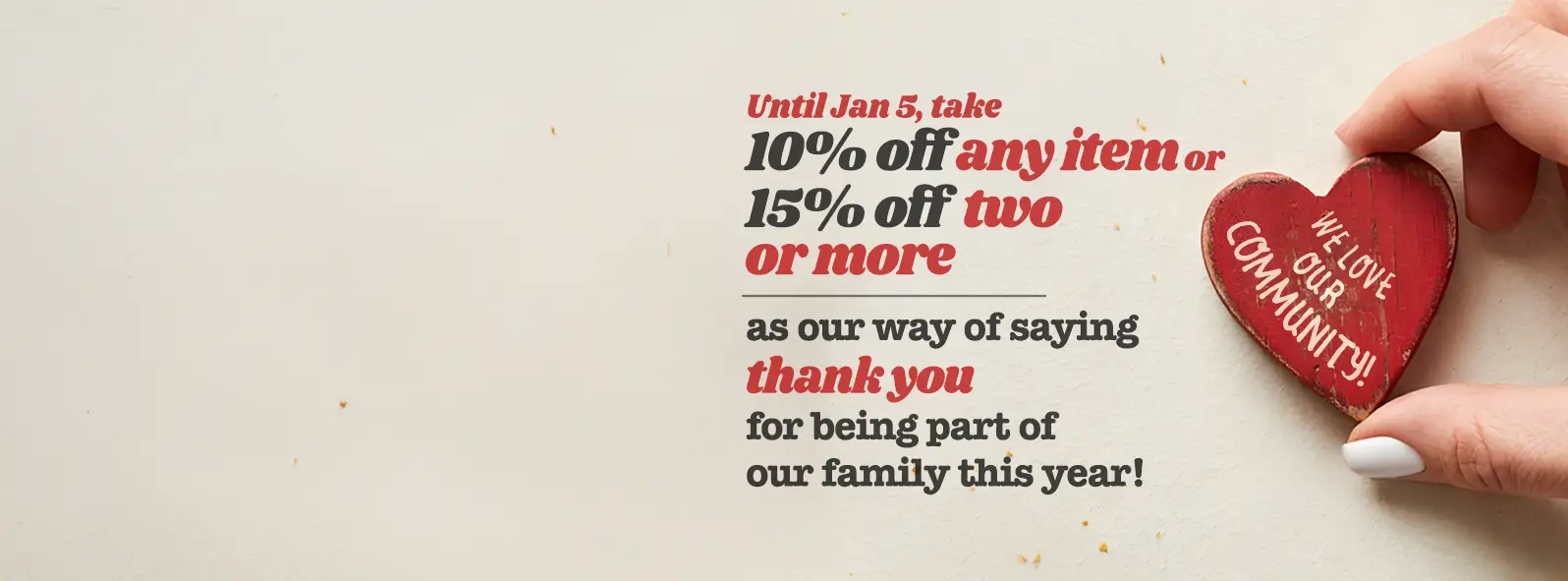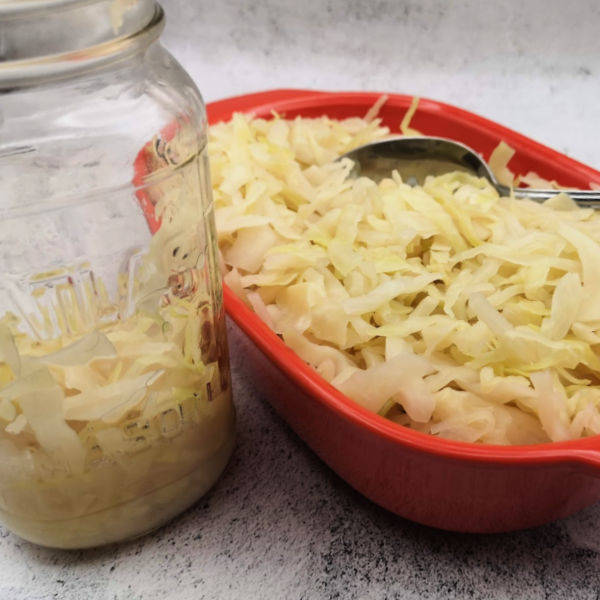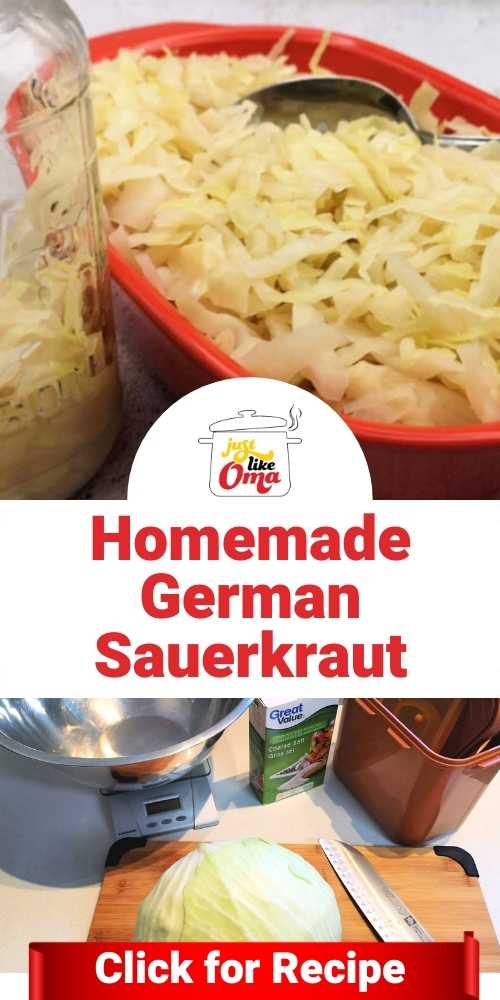Spice up your inbox with FREE German recipes and an exclusive free recipe ebook!
Our thank you sale is on now - save 10% off any item, or 15% off two or more!
Spice up your inbox with FREE German recipes and an exclusive free recipe ebook!
- Home
- Side Dishes
- Homemade Sauerkraut
Oma's Easy Homemade Sauerkraut

by: Gerhild Fulson / Oma Gerhild shares German recipes rooted in family tradition.
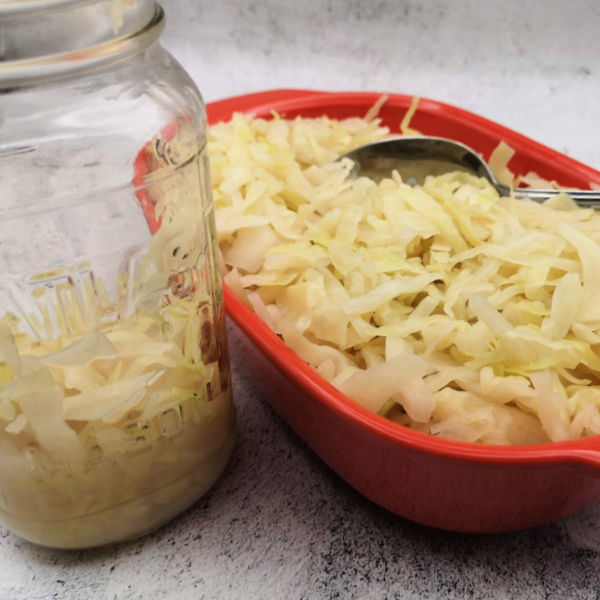 Learn how to easily make your own sauerkraut at home, without smelling up the house!
Learn how to easily make your own sauerkraut at home, without smelling up the house!Homemade sauerkraut recipe. There's nothing quite like it. Amazingly delicious and wonderfully healthy. You'll be amazed how easy this is to make with Oma's tips.
Cabbage, whether green or red, is so common throughout Germany. It's used in salads, side dishes, soups, main dishes, and particularly in this fermented form, sauerkraut, literally 'sour cabbage'.
Although sauerkraut is known as one of Germany's most traditional foods, its origin stems from China where it was originally fermented with rice wine. In the 16th century Germans improved this version by using salt instead of the rice wine and sauerkraut, as we know it today, was born.
At its simplest, sauerkraut contains only shredded cabbage and salt. The salt draws out the cabbage juices and fermentation by lactobacilli begins. These bacteria occur naturally on the fresh cabbage leaves, meaning that nothing needs to be introduced to get the process started.
There are several stages of the fermentation process that produces varying degrees of sourness. Making one's own sauerkraut lets one regulate the level of sourness one likes.
Or be more adventuresome and add carrots, beets, cranberries, apples, pineapple, red cabbage, pears, bell peppers or turmeric powder. In some parts of Germany, juniper berries, bay leaves, dill, and/or caraway seeds are added.
My Sauerkraut Story
Many years ago I owned a 2-gallon fermentation crock, well actually a a large, open crock with no lid. I don't quite recall what I used as fermentation weights, but I seem to recall a large plate with a brick in a plastic bag on it and covered with a towel.
As much as we loved sauerkraut, we really didn't love the 'fragrance' that it emitted as it fermented for weeks. Then the years passed by. I gave the crock away and somehow settled for grocery store sauerkraut.
Until just recently. I came across an interesting container that is sold to make Kimchi.
Kimchi, also known as Korean Kraut, is similar to sauerkraut because it is also fermented cabbage. That, however, where the similarity ends. Kimchi is more crunchy, more salty, but less acidic and often includes cabbage, carrots, cucumbers, scallions, garlic, ginger, salt, and fish sauce.
Since Kimchi also depends upon an anaerobic process for the fermentation to occur safely, I figured it would be perfect for making sauerkraut. I was right!!!
What makes this E-Jen container so perfect is that it has an inner vacuum lid. NO ODORS at all escape from it.
It can stay on my kitchen counter at room temperature until the cabbage mixture has fermented to the right degree of sourness. I can then either freeze the sauerkraut or just put the container into the fridge to slow the fermentation process and use it from there. Never any smell ... until you open it. Then the sauerkraut fragrance wafts through the room and it's time to make dinner.
The E-Jen container comes in a huge variety of sizes, from 0.45 gallon to 4.4 gallon. I have the 0.9 gallon size since it fits nicely in my fridge without taking too much space.
Is Sauerkraut Good For You?
Absolutely! Fermented foods are rich in beneficial bacteria, and sauerkraut is especially rich in lactobacillus bacteria and are good for your gut and your immune system. Sauerkraut is packed with enzymes, probiotics, vitamins B and C ... and so much more.
Have it raw in a salad for maximum health benefits. Eat a spoonful or two before meals to help you digest your food better. Raw sauerkraut is considered one of the superfoods with the highest vitamin C content and when it's made with red cabbage, that's even better.
Although raw is best, cooked is so delicious and still healthy. To regain some of the probiotic benefits, it is a good idea to add a bit of raw sauerkraut to the finished cooked dish.
How to Make Sauerkraut in a Mason Jar
Using mason jars to make sauerkraut is all the rage now. Yes, it's definitely doable. There are all sorts of airlocks one can buy that releases the gases that build up in the jar. One can also just use a water-filled baggie as a weight to keep the cabbage submerged and manually 'burp' the gases.
But, there will still be that sauerkraut odor that will waft through the house until the fermentation process is over. That can be from 1 week to several weeks. Make sure you keep the jar in a dark place out of direct sunlight.
The method below works for using a fermentation crock, mason jars, or the E-Jen container. The only difference is going to be the amount. For the photos shown here, I used a 3 pound head of cabbage. It filled my 0.9 gallon E-Jen container about ⅓ full. This would also fill 2 1-quart mason jars.
You do not need to sterilize your mason jar or other containers. Just wash well with soup, rinse, and dry, or use the dishwasher. Everything you use should be clean, but sterile is not necessary.
What Kind of Cabbage Should You Use?
The best cabbage to use is the regular round-headed green cabbage, sometimes called white cabbage. When you are choosing it, it should be compact, firm, and heavy for its size, meaning it is fresh. Fresh is best!
Choose cabbage that has shiny and bright-colored leaves that are crisp and not wilted or brown. The leaves should taste and smell sweet. Newly harvested is best because it will have a higher moisture content that creates more juices for the brine.
Ideally you want to use winter cabbage, cabbage that is grown for storage and is harvested in late fall. This type has a more compact structure and higher moisture content than the summer variety.
How to Cut Cabbage for Sauerkraut
Rinse the cabbage and remove the coarse outer leaves.
Using a large knife, cut the cabbage in half and then slice each half in half to get four quarters.
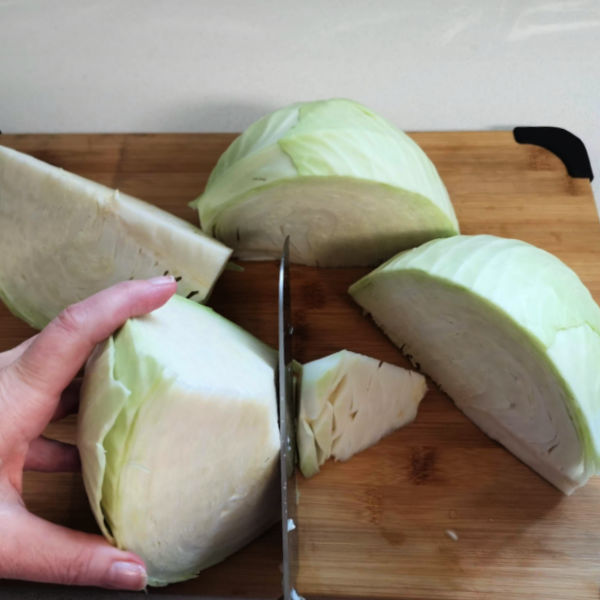 Cut cabbage into quarters and remove the core
Cut cabbage into quarters and remove the coreSlice the cabbage as thinly as you wish. I cut mine on the thicker size, but thinner is more traditional.
Some people like to keep the core attached to each quarter to make slicing the cabbage easier. It give a place to hold it while the slicing is happening. Then the core is thrown away.
My Mutti taught me to cut the core away and then slice, so that's how I've always done it. Both ways work well.
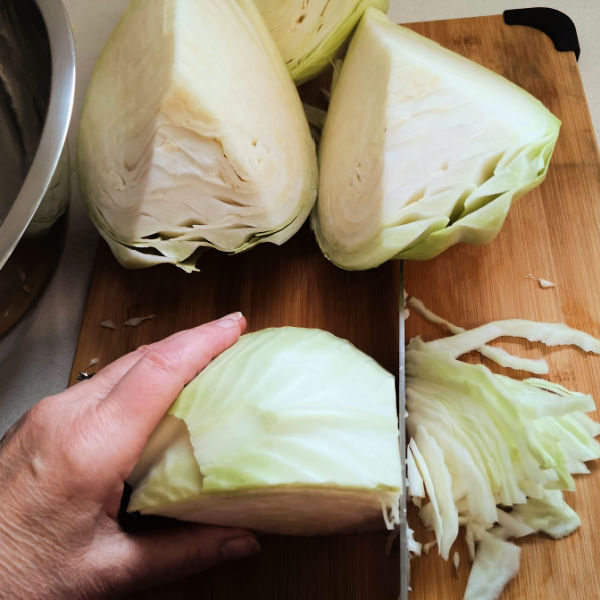 Slice cabbage as thinly as you wish
Slice cabbage as thinly as you wishA large chef knife works best. If you're wanting to make sauerkraut frequently, then perhaps getting a cabbage knife (it has a double blade) would be an idea. If you have a mandolin, it makes quick work to get even and thin slices. Wearing cut-resistant gloves would be an asset with this.
You can also use your food processor with the large grating disc to make quick work of this.
How Much Salt Should You Use?
Ideally, to ferment the cabbage properly, one should aim for a 2% salt solution. That means you'll use about 1½ teaspoons of salt for every pound of cabbage. Using a scale is actually best. You'll use about 20 grams of salt for every kilogram of cabbage.
The right amount of salt is necessary to encourage proper bacteria growth. Too much salt will hinder this. Too much salt will give you pickled cabbage, not fermented cabbage. Too little could allow harmful bacteria, mold, or yeast to grow.
What Kind of Salt Should You Use?
There are so many salts one can choose from. Start with sea salt first, finely ground. Avoid using any salt that contains iodine anti-caking agents as that can interfere with the fermentation. Himalayan pink salt is good as well.
For the batch I took photos of, I used canning salt. It was rather coarse, so grinding it with my mortar and pestle was needed.
A Quick Overview Making Sauerkraut
Get everything ready. Wash and cut cabbage into quarters and remove the core. Shred the cabbage as thinly as you wish and put into a large bowl.
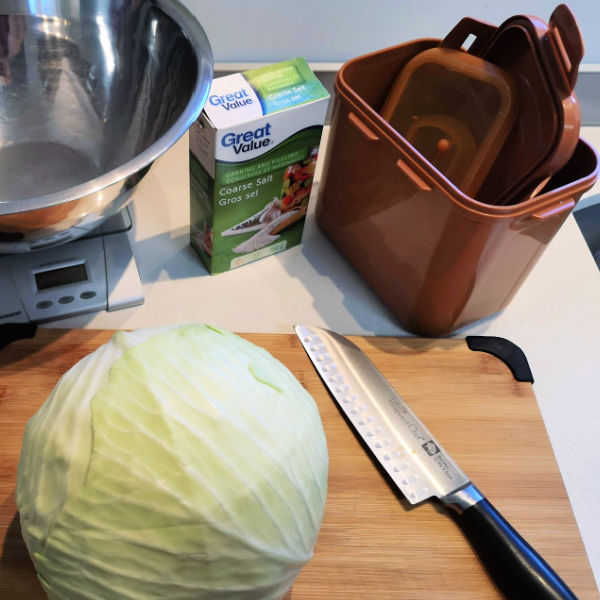 This is all that's needed This is all that's needed |
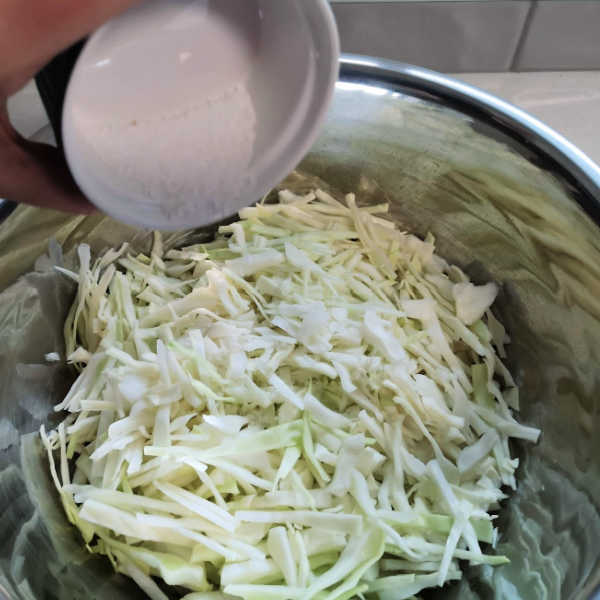 Add salt to shredded cabbage Add salt to shredded cabbage |
Weigh the cabbage and adjust the quantities of salt so that you'll end up with a 2% salt solution. 1½ teaspoons of salt for every pound of cabbage.
Mix in the salt and cover with a towel. Let it sit for about 15 minutes for the cabbage to start 'sweating'. The salt will begin to draw out the cabbage juices.
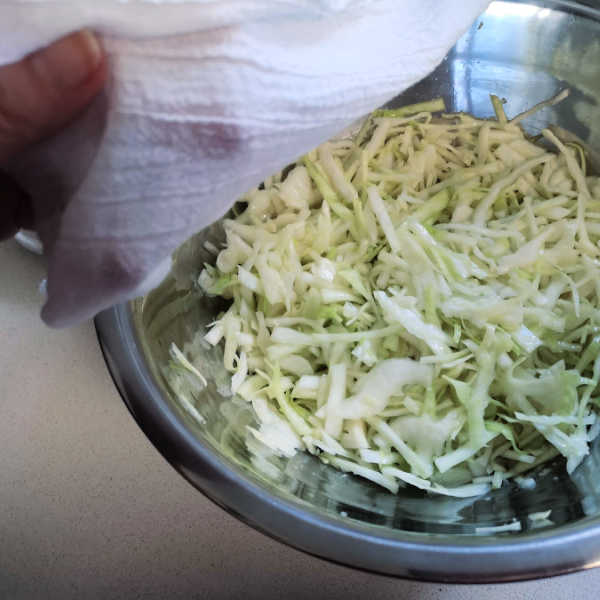 let the cabbage "sweat" let the cabbage "sweat" |
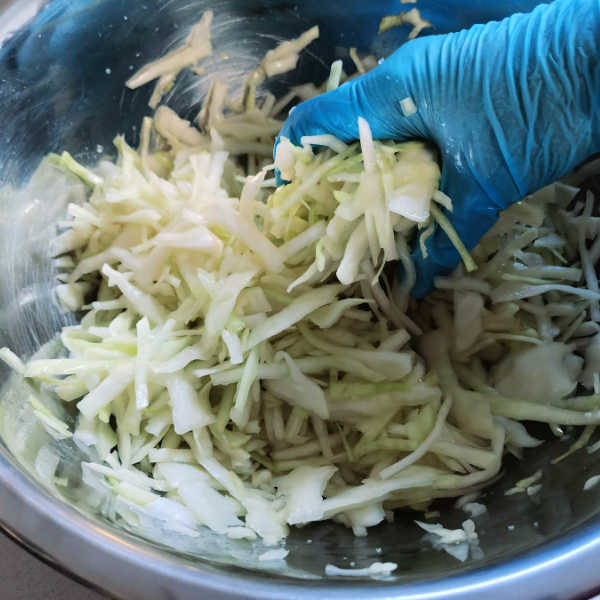 Give it a "massage" Give it a "massage" |
After letting it sit, vigorously massage the cabbage/salt mixture with your hands. The juices being released from the cabbage mixes with the salt to create the brine that will ferment the cabbage.
I like to use disposable gloves for this, but you can use your bare hands. As well, one can buy sauerkraut stompers or pounders to use instead.
You'll be surprised how much brine is produced by this method.
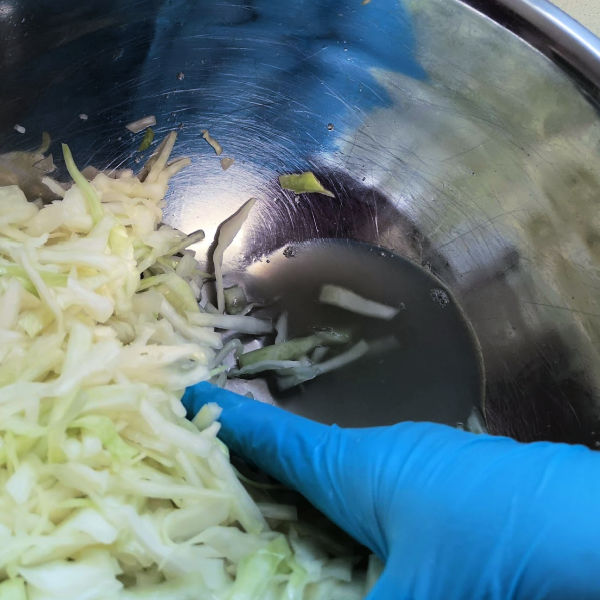 Brine starting to form Brine starting to form |
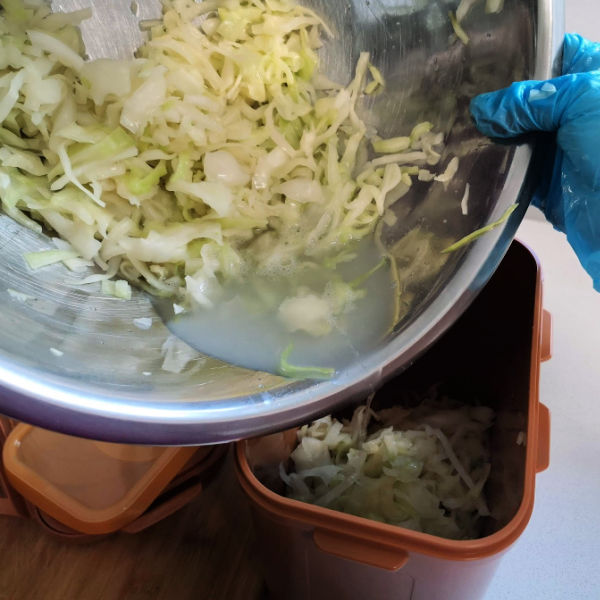 Fill E-jen container Fill E-jen container |
Above, I'm filling my E-Jen container. Put all the brine in. If you're using mason jars, you'll want to fill them in such a way that you have space to add a fermentation weight or plastic baggie filled with water as your weight.
The shredded cabbage needs to be kept below the level of the brine in order that none of it spoils.
Below, I have the airlock open as I press down the air tight lid. Once the brine starts to bubble up through that hole, I close the airlock.
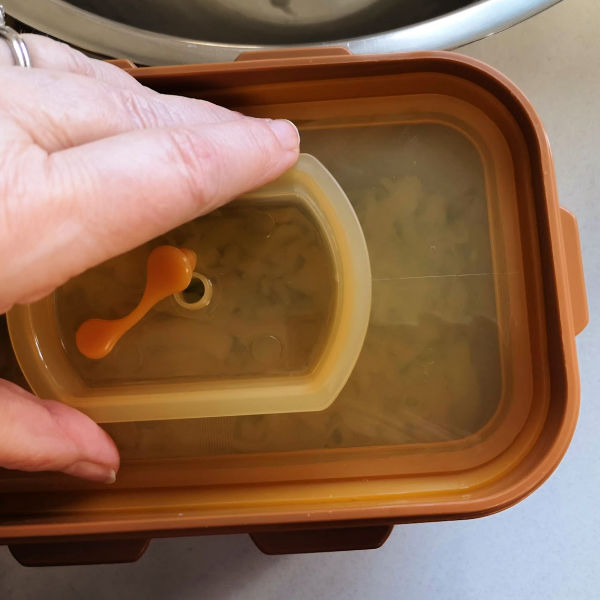 press down with air lock open so air can escape press down with air lock open so air can escape |
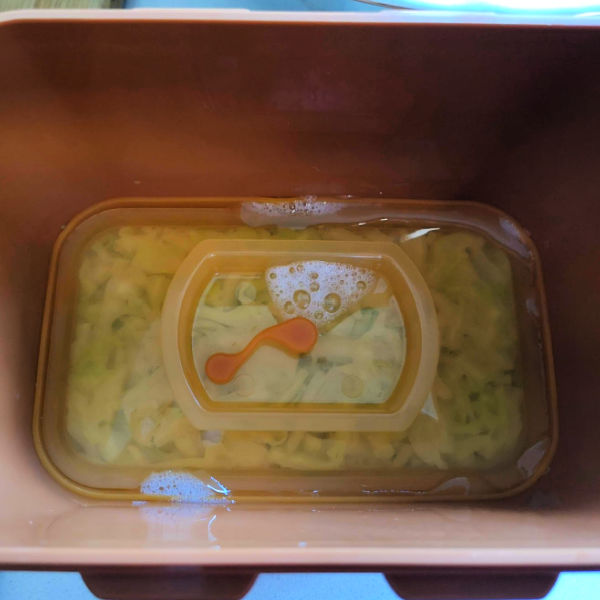 close air lock once brine starts to bubble out close air lock once brine starts to bubble out |
Airtight, this is now ready to put the container's lid on and let it sit on my kitchen counter. It can ferment without those sauerkraut odors filling my kitchen for weeks. I love to start nibbling on is every so often as it continues to get to the nice sour taste that we want.
Can you tell that I LOVE my E-Jen?
Recipes Using Your Homemade Sauerkraut
Now that you've made your first batch of sauerkraut, what are you going to do with it, besides using it as a fresh condiment on hotdogs or sausage? Here are some of my favorite recipes:
- Sauerkraut salad, a refreshing change
- Sauerkraut, as a cooked side dish
- Sauerkraut and pork hocks
- Sauerkraut soup, so easy and so good
- Sauerkraut casserole, a great way to use up leftover cooked sauerkraut
- Bratwurst and sauerkraut, a traditional German dinner
Ready to make some homemade sauerkraut?
The recipe below will make enough for 2 mason jars. If you are using the E-Jen container, adjust the quantities accordingly. For my 0.9 gallon container, I use up to 8 pounds of cabbage. Weigh your cabbage and adjust the salt with the same ratio as below.
Oma's Easy Homemade Sauerkraut
Homemade sauerkraut recipe. There's nothing quite like it. Amazingly delicious and wonderfully healthy. You'll be amazed how easy this is to make with Oma's tips.
You can use mason jars or the E-Jen container with the inner vacuum lid so no odors waft through your kitchen for weeks during the fermentation process.
Prep Time:
50 minutes
Fermentation Time:
1 - 4 weeks
Total Time:
1 - 4 weeks
Servings:
Makes 12 servings
Ingredients:
- 3 pounds (1.3 kilograms) green cabbage
- 1½ tablespoon (30 grams) sea salt, finely ground
Instructions:
- Wash cabbage, remove outer leaves and cut in quarters. Cut out the core and using a large knife or a mandolin, thinly slice each quarter.
- Weigh the cabbage and use the above ratio to calculate the amount of salt to add.
- Put the sliced cabbage into a large mixing bowl and add the salt. Mix and let stand for about 15 minutes. With clean hands, vigorously massage and squeeze the cabbage for about 5 to 10 minutes.
- The cabbage will release its juices, the more the better. This is the brine that will cover the cabbage during fermentation.
- Pack the cabbage into your container(s), pressing down with your fist or a wooden spoon to push the cabbage under the liquid and no air bubbles remain. If you have fermentation weights, use them. If you don't and are using a mason jar, fit a zip-top freezer bag into the jar, making sure it covers the entire surface of the cabbage. Fill the bag with cool water and seal, pressing out as much air as possible. Tuck the top into the jar and cover with a towel. If you are using the E-Jen, open the air lock, press down on the inner vacuum lid until the brine starts to bubble out of the air lock hole, and press the air lock in place. Place the lid on.
- Set your jars/container on your kitchen counter (cover with towel to keep jars dark) at around 65 to 75℉ for at least 1 week. You can taste it and see how you like it. Ideally, keep it fermenting for 2 to 4 weeks.
- When the sauerkraut is sour enough to your taste, place it in the fridge to store. It will keep for up to 1 year.
Notes/Hints:
- If there is not enough brine to cover your cabbage, mix 1½ teaspoons of salt into 1 cup of water. Pour enough of this brine over the cabbage to submerge it.
- If your jar is very full, place it in a shallow bowl because there will be bubbling going on for the first week. You will need to 'burp' the air lock on the E-Jen during this time.
- Add a few bay leaves or ½ teaspoon caraway seeds to the top of the cabbage in the jar/E-Jen before closing.
- For greatest health benefits, eat this raw, perhaps in the sauerkraut salad. To cook, see Oma's German sauerkraut recipe, sauerkraut soup, and this amazing sauerkraut casserole.
* * * * *
Unless otherwise noted recipe, images and content © Just like Oma | www.quick-german-recipes.com
Comments? Questions?
You can leave a comment about this recipe or ask a question...
Pop right over to my private Facebook group, the Kaffeeklatschers. You'll find thousands of German foodies, all eager to help and to talk about all things German, especially these yummy foods.
Meet with us around Oma's virtual table, pull up a chair, grab a coffee and a piece of Apfelstrudel, and enjoy the visit.
Recent Articles
-
Black Forest Hot Chocolate (German-Inspired Christmas Drink)
Dec 24, 25 10:48 AM
Rich Black Forest hot chocolate with dark chocolate, cocoa, whipped cream, and a splash of cherry liqueur. Warming German-inspired Christmas drink. -
Pork Schnitzel Sliders (Mini German Sandwiches with a Crunch)
Dec 17, 25 11:05 AM
Crispy pork schnitzel sliders recipe. Bite-sized German sandwiches perfect for parties, game day, or Oktoberfest. -
Oma's German Rhubarb Cake With Streusel (Rhabarberkuchen mit Streusel)
Dec 13, 25 11:14 PM
This German Rhubarb Cake (Rhabarberkuchen mit Streusel) tastes just like Mutti’s … sweet, tart, buttery, and baked with love.
Words to the Wise
"The godly are showered with blessings; the words of the wicked conceal violent intentions."
Proverbs 10:6 (NLT)
